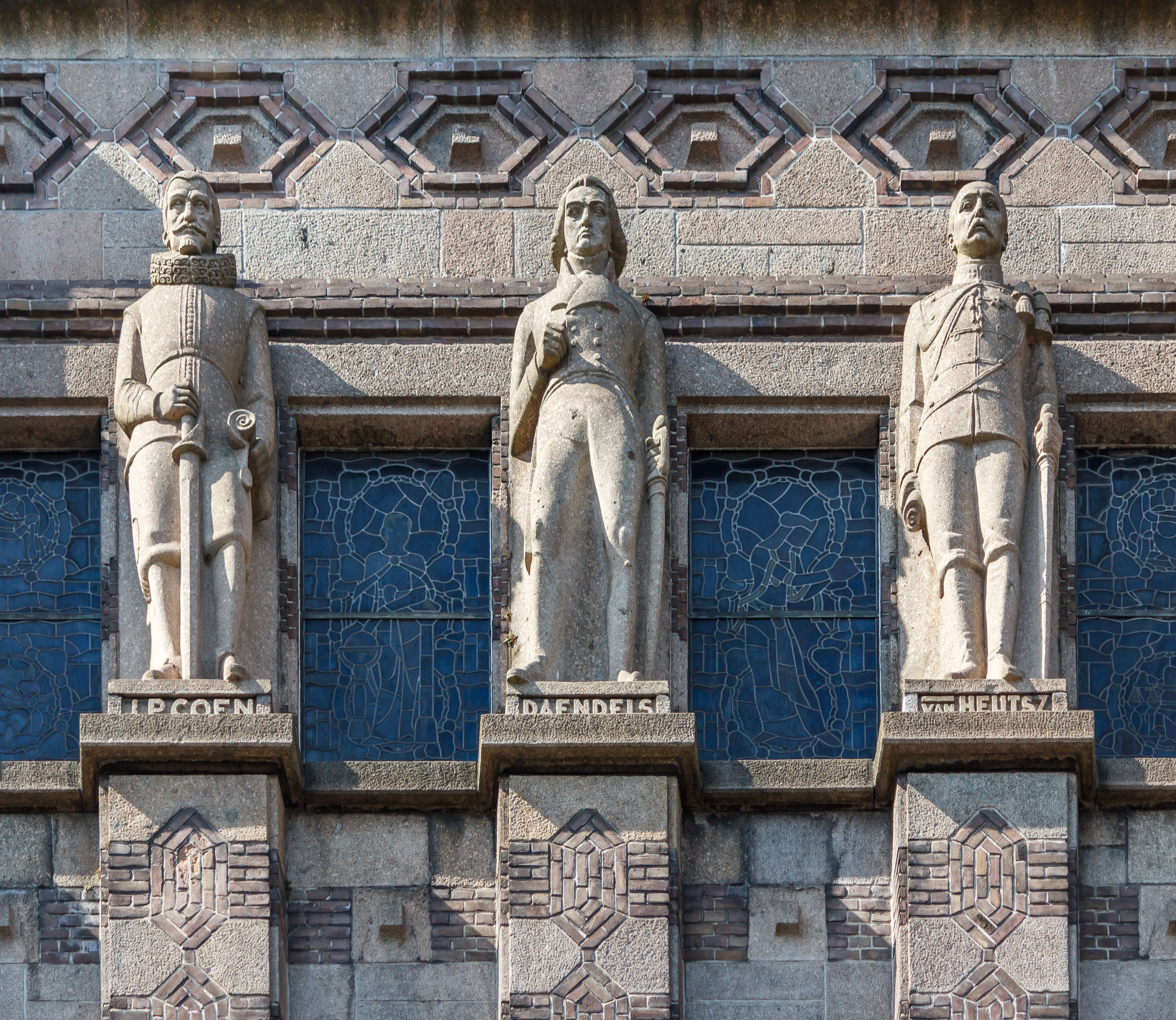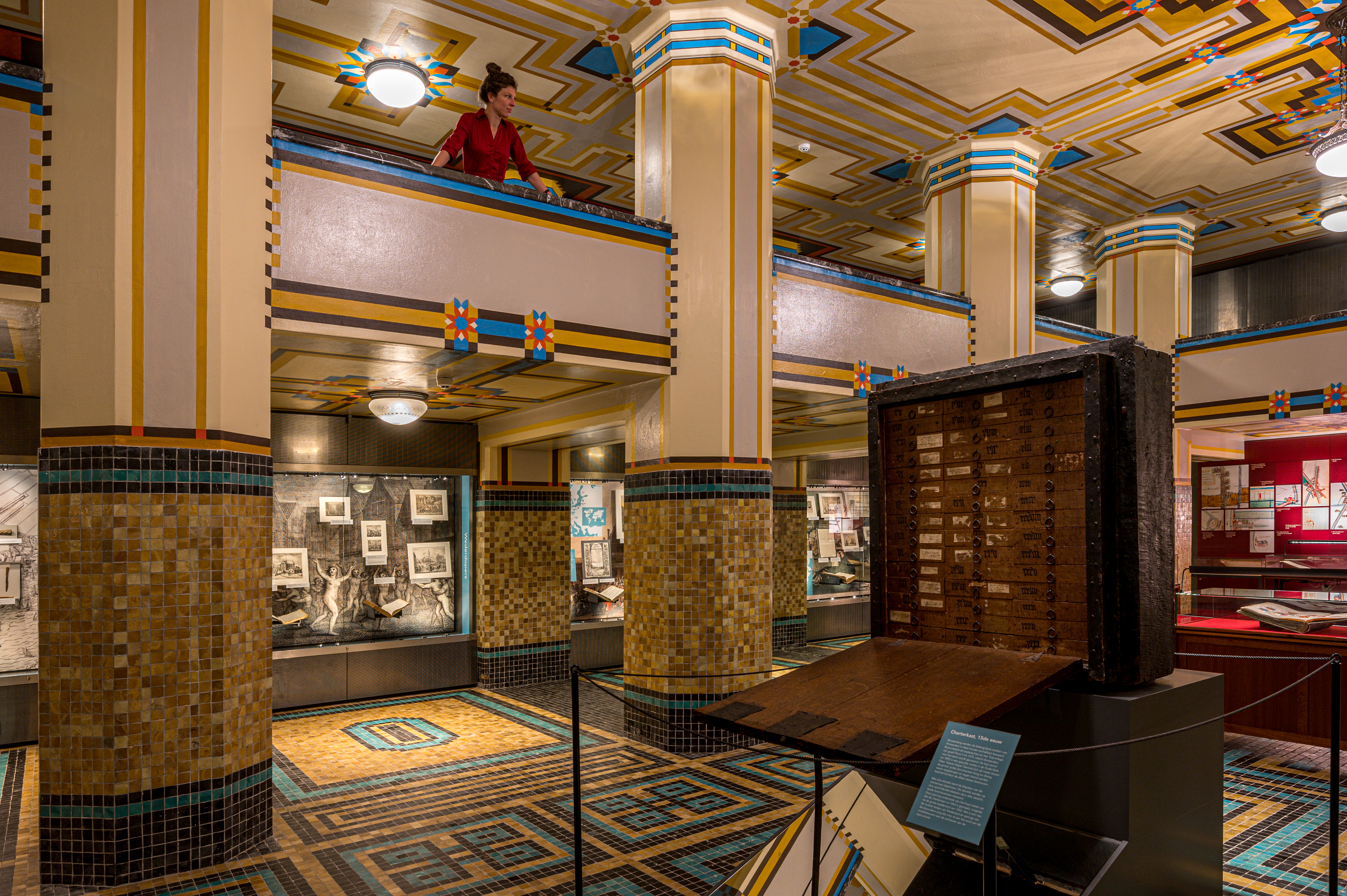|
De Bazel
De Bazel is a listed/protected historic building on the west side of the Vijzelstraat in Amsterdam (at number 32), and stretches from the Herengracht to the Keizersgracht. It stands as an example of Brick Expressionism. History The building was the most important work of the Dutch architect Karel de Bazel and was built from 1919 to 1926 as the head office of the Nederlandsche Handel-Maatschappij (NHM).Rijksmonument report The architect died in 1923, three years before completion. Construction was continued by his ''chef de bureau'' C. van de Linde, together with designer Adolf Leonard van Gendt. Sculptures on the outside of the building are by Joseph Mendes da Costa, Lambertus Zijl and Hendrik A. van den Eijnde. The stained glass windows were made by Joep Nicolas after designs by Antoon Derkinderen. The building was titled ''De Spekkoek'', after the Dutch-Indonesian delicacy spekkoek, but is now named after the architect. Colonial History The building commemorates the his ... [...More Info...] [...Related Items...] OR: [Wikipedia] [Google] [Baidu] |
Antoon Derkinderen
Antonius Johannes (Antoon) Derkinderen ('s-Hertogenbosch, 20 December 1859 – Amsterdam, 2 November 1925) was a Dutch painter, Glass artist, Draftsman and designer of book covers. Life Early Years Antoon Derkinderen was born in 's-Hertogenbosch in 1859 to Antonius Henricus Derkinderen, gold- and silversmith, and Hendrica de Rooij. At the time the town was deeply Catholic and conservative. From 1874 to 1878 Derkinderen went to the daytime school for primary school teachers in 's-Hertogenbosch. The simple reason why Derkinderen went to this school, was that the education was solid and free of charge. He also became qualified to teach drawing and mathematics. Derkinderen would lead the choir of this school with very much enthusiasm. In May 1878 Derkinderen qualified as an assistant teacher for primary education. In his hometown 's-Hertogenbosch, Derkinderen then went to the Royal School of Applied and Visual Arts from 1878 to 1880. This school was led by J.Th. Stracké. ... [...More Info...] [...Related Items...] OR: [Wikipedia] [Google] [Baidu] |
Three Colonial Generals De Bazel Vijzelstraat Amsterdam 2016-09-13-6629
3 is a number, numeral, and glyph. 3, three, or III may also refer to: * AD 3, the third year of the AD era * 3 BC, the third year before the AD era * March, the third month Books * ''Three of Them'' (Russian: ', literally, "three"), a 1901 novel by Maksim Gorky * ''Three'', a 1946 novel by William Sansom * ''Three'', a 1970 novel by Sylvia Ashton-Warner * ''Three'' (novel), a 2003 suspense novel by Ted Dekker * ''Three'' (comics), a graphic novel by Kieron Gillen. * ''3'', a 2004 novel by Julie Hilden * ''Three'', a collection of three plays by Lillian Hellman * ''Three By Flannery O'Connor'', collection Flannery O'Connor bibliography Brands * 3 (telecommunications), a global telecommunications brand ** 3Arena, indoor amphitheatre in Ireland operating with the "3" brand ** 3 Hong Kong, telecommunications company operating in Hong Kong ** Three Australia, Australian telecommunications company ** Three Ireland, Irish telecommunications company ** Three UK, British telecom ... [...More Info...] [...Related Items...] OR: [Wikipedia] [Google] [Baidu] |
Foundation (architecture)
In engineering, a foundation is the element of a structure which connects it to the ground, transferring loads from the structure to the ground. Foundations are generally considered either shallow or deep. Foundation engineering is the application of soil mechanics and rock mechanics ( geotechnical engineering) in the design of foundation elements of structures. Purpose Foundations provide the structure's stability from the ground: * To distribute the weight of the structure over a large area in order to avoid overloading the underlying soil (possibly causing unequal settlement). * To anchor the structure against natural forces including earthquakes, floods, droughts, frost heaves, tornadoes and wind. * To provide a level surface for construction. * To anchor the structure deeply into the ground, increasing its stability and preventing overloading. * To prevent lateral movements of the supported structure (in some cases). Requirements of a good foundation The design and the ... [...More Info...] [...Related Items...] OR: [Wikipedia] [Google] [Baidu] |
Granite
Granite () is a coarse-grained (phaneritic) intrusive igneous rock composed mostly of quartz, alkali feldspar, and plagioclase. It forms from magma with a high content of silica and alkali metal oxides that slowly cools and solidifies underground. It is common in the continental crust of Earth, where it is found in igneous intrusions. These range in size from dikes only a few centimeters across to batholiths exposed over hundreds of square kilometers. Granite is typical of a larger family of ''granitic rocks'', or ''granitoids'', that are composed mostly of coarse-grained quartz and feldspars in varying proportions. These rocks are classified by the relative percentages of quartz, alkali feldspar, and plagioclase (the QAPF classification), with true granite representing granitic rocks rich in quartz and alkali feldspar. Most granitic rocks also contain mica or amphibole minerals, though a few (known as leucogranites) contain almost no dark minerals. Granite is nearly alway ... [...More Info...] [...Related Items...] OR: [Wikipedia] [Google] [Baidu] |
Brick
A brick is a type of block used to build walls, pavements and other elements in masonry construction. Properly, the term ''brick'' denotes a block composed of dried clay, but is now also used informally to denote other chemically cured construction blocks. Bricks can be joined using mortar, adhesives or by interlocking them. Bricks are usually produced at brickworks in numerous classes, types, materials, and sizes which vary with region and time period, and are produced in bulk quantities. ''Block'' is a similar term referring to a rectangular building unit composed of similar materials, but is usually larger than a brick. Lightweight bricks (also called lightweight blocks) are made from expanded clay aggregate. Fired bricks are one of the longest-lasting and strongest building materials, sometimes referred to as artificial stone, and have been used since circa 4000 BC. Air-dried bricks, also known as mud-bricks, have a history older than fired bricks, and have an additi ... [...More Info...] [...Related Items...] OR: [Wikipedia] [Google] [Baidu] |
Framing (construction)
Framing, in construction, is the fitting together of pieces to give a structure support and shape. Framing materials are usually wood, engineered wood, or structural steel. The alternative to framed construction is generally called ''mass wall'' construction, where horizontal layers of stacked materials such as log building, masonry, rammed earth, adobe, etc. are used without framing. Building framing is divided into two broad categories, heavy-frame construction (heavy framing) if the vertical supports are few and heavy such as in timber framing, pole building framing, or steel framing; or light-frame construction (light-framing) if the supports are more numerous and smaller, such as balloon, platform, or light-steel framing. Light-frame construction using standardized dimensional lumber has become the dominant construction method in North America and Australia due to the economy of the method; use of minimal structural material allows builders to enclose a large area at mini ... [...More Info...] [...Related Items...] OR: [Wikipedia] [Google] [Baidu] |
Concrete
Concrete is a composite material composed of fine and coarse aggregate bonded together with a fluid cement (cement paste) that hardens (cures) over time. Concrete is the second-most-used substance in the world after water, and is the most widely used building material. Its usage worldwide, ton for ton, is twice that of steel, wood, plastics, and aluminum combined. Globally, the ready-mix concrete industry, the largest segment of the concrete market, is projected to exceed $600 billion in revenue by 2025. This widespread use results in a number of environmental impacts. Most notably, the production process for cement produces large volumes of greenhouse gas emissions, leading to net 8% of global emissions. Other environmental concerns include widespread illegal sand mining, impacts on the surrounding environment such as increased surface runoff or urban heat island effect, and potential public health implications from toxic ingredients. Significant research and development is ... [...More Info...] [...Related Items...] OR: [Wikipedia] [Google] [Baidu] |
Beatrix Of The Netherlands
Beatrix (Beatrix Wilhelmina Armgard, ; born 31 January 1938) is a member of the Dutch royal house who reigned as Queen of the Netherlands from 1980 until her abdication in 2013. Beatrix is the eldest daughter of Queen Juliana and her husband, Prince Bernhard of Lippe-Biesterfeld. Upon her mother's accession in 1948, she became heir presumptive. Beatrix attended a public primary school in Canada during World War II, and then finished her primary and secondary education in the Netherlands in the post-war period. In 1961, she received her law degree from Leiden University. In 1966, Beatrix married Claus von Amsberg, a German diplomat, with whom she had three children. When her mother abdicated on 30 April 1980, Beatrix succeeded her as queen. Beatrix's reign saw the country's Caribbean possessions reshaped with Aruba's Status aparte, secession and becoming its own Countries of the Kingdom of the Netherlands, constituent country within the kingdom in 1986. This was followed by ... [...More Info...] [...Related Items...] OR: [Wikipedia] [Google] [Baidu] |
Amsterdam City Archives
The Amsterdam City Archives ( nl, Stadsarchief Amsterdam) preserves documents pertaining to the history of Amsterdam and provides information about the city. With archives covering a shelf-length of about 50 kilometres, the Amsterdam City Archives is the largest municipal archive in the world. History In the Middle Ages, Amsterdam’s important documents were stored in a special cabinet that was kept in the so-called ‘Iron Chapel’ (IJzeren Kapel) in the Old Church ( Oude Kerk). In the nineteenth century, the archives moved to the Waag building at the Nieuwmarkt, and in 1914 to the former town hall of Nieuwer-Amstel. Since the summer of 2007, the Amsterdam City Archives have been located in the monumental building De Bazel, in the city-centre, which derives its name from the famous Dutch architect K.P.C. de Bazel, who designed it. Preservation The Amsterdam City Archives belongs to the government of Amsterdam. It preserves the archives of the municipal government and of the nat ... [...More Info...] [...Related Items...] OR: [Wikipedia] [Google] [Baidu] |








